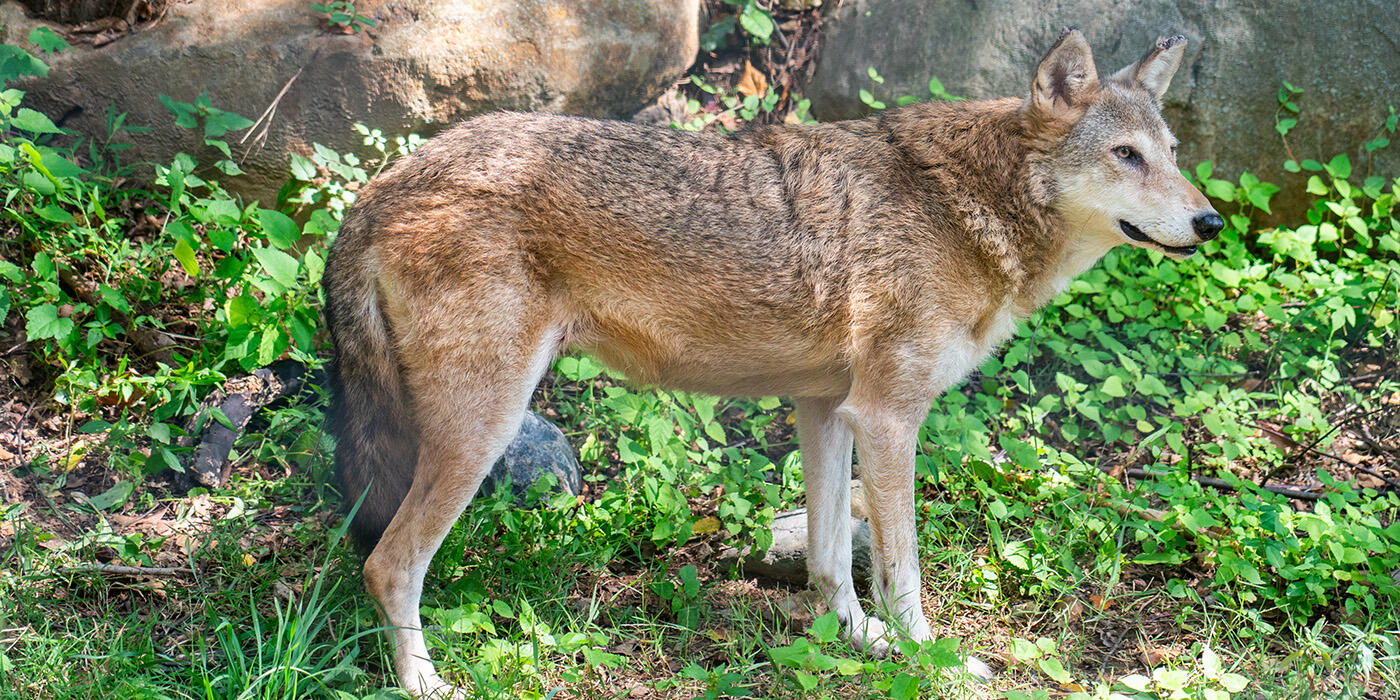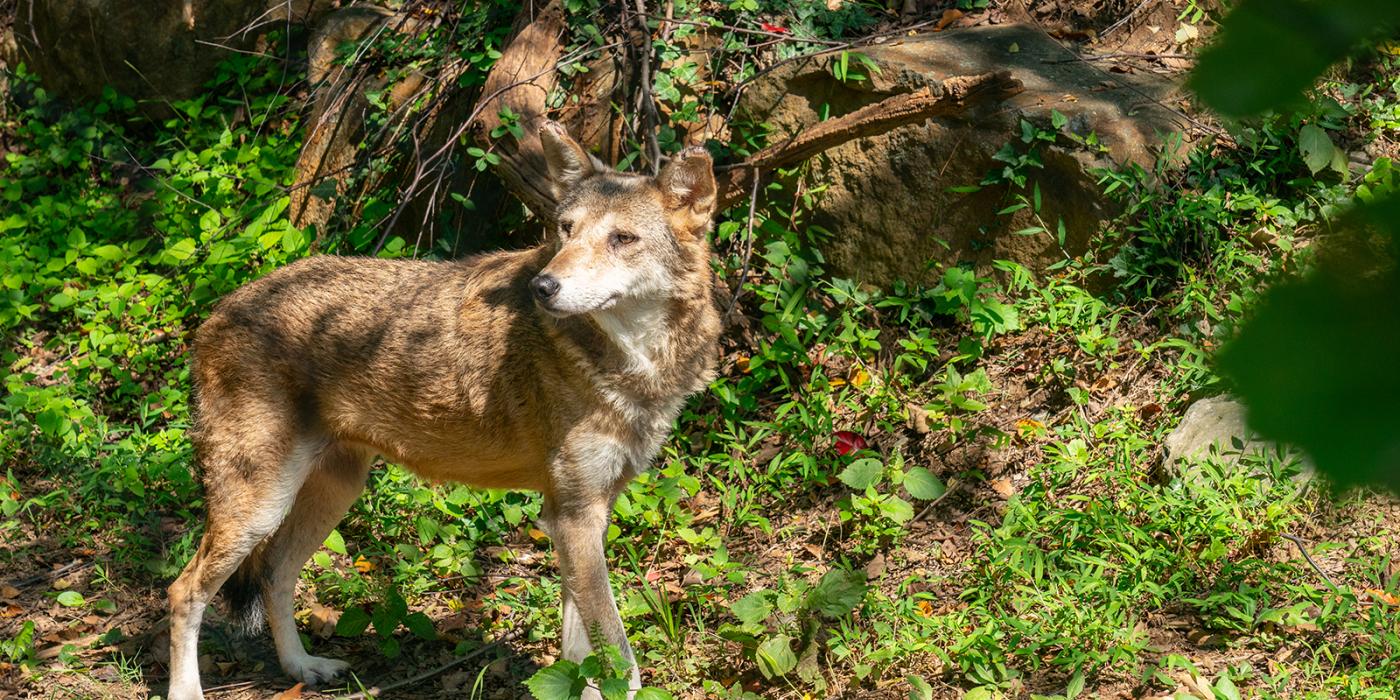Physical Description
Red wolves have a distinct reddish tinge to their coat, particularly on the ears, head and legs. Adult red wolves tend to resemble their cousins, the gray wolves, but are usually smaller, and with longer, lankier legs, taller ears and a thinner body. They are often described as resembling a mix between a gray wolf and a coyote.
Despite the name, their coats can vary quite a bit in color. Some have tawny or cinnamon-colored fur, while others have more gray and black tones mixed into their coats. Their undersides are usually colored white or pinkish-red.
Size
Red wolves are large canids, but slightly smaller than their cousin, the gray wolf. Adults measure about 4 to 5 feet (1.2-1.5 meters) long from nose to tail and stand about 26 inches (66 centimeters) at the shoulder. They weigh between 40-80 pounds (18-36 kilograms).
Native Habitat
These “All-American” wolves are found only in the United States. They once roamed freely in forests, swamps and coastal prairies, ranging from Texas to Pennsylvania. Currently, their wild population is limited to just a single designated recovery area in northeastern North Carolina.
Lifespan
They live for about 7-10 years in the wild. In human care, they can live up to 16 years.
Communication
Red wolves use a wide variety of vocalizations to communicate with each other, including barks, growls and yaps. Like other wolves, they can communicate over long distance through their howl—these howls are used as a social rally call, a hail to hunt or as a territorial expression. A wolf’s howl can be heard from several miles away.
They also communicate through physical gestures, such as swishing their tails and twitching their noses, or by scent marking their territory with urine and gland secretions.
Food/Eating Habits
Red wolves are carnivores, eating up to five pounds of meat a day. In the wild, they hunt in packs, ranging up to 20 miles a day within their home territories to find prey. Capable of running up to 30 miles per hour (48 kilometers per hour) and swimming for long periods of time, they can move quickly throughout their territories, which range up to 30,000 square miles (75,000 square kilometers) in size.
As apex predators, they help maintain the population levels of the other animals within their native habitat, which in turn keeps the local ecosystem in balance. Common prey animals include white-tailed deer, raccoons, turkeys, opossums, nutria, and smaller animals like rabbits, birds and mice. They will also eat carrion and have been known to eat insects, berries and some plant materials.
Sleep Habits
Red wolves are crepuscular and nocturnal, meaning they are active at nighttime but usually peak in activity around dawn or dusk. Red wolves usually sleep close together with their pack mates.
Social Structure
Red wolves are highly social animals. In the wild, they live in family groups, or packs, that can number between two to ten individuals. These packs usually include a pair of breeding adults and their offspring, who travel with the pack while young and leave to form their own packs once they reach adulthood. They are very territorial and will defend their established range from other animals, but they are quite shy around humans.
Reproduction and Development
Red wolves are monogamous, remaining with the same mate for their whole lives.
Pairs usually mate once a year, giving birth to a litter of four to six pups in April or May. Dens are hidden away among hollow trees, sandy knolls, stream banks or piles of debris. Both parents help raise their young, bringing food back to the den until the pups are old enough to join the hunt. Other members of the pack—usually offspring from a previous litter—help protect and care for the young pups.
Red wolves grow to their full size after about one year and become sexually mature around two to three years old. However, disease, predation from other animals and lack of food resources mean that only about half of all cubs reach adulthood.
Conservation Efforts
American red wolves used to be found across the eastern United States, but in 1980, after decades of habitat loss and hunting, America’s only endemic wolf was declared extinct in the wild. The current wild population is found only in coastal North Carolina and is the result of a careful captive breeding and reintroduction program supported by zoos and wildlife conservation organizations.
Help this Species
Practice ecotourism by being an advocate for the environment when you’re on vacation. During your travels, support, visit or volunteer with organizations that protect wildlife. Shop smart too! Avoid buying products made from animals, which could support poaching and the illegal wildlife trade.
Support organizations like the Smithsonian’s National Zoo and Conservation Biology Institute that research better ways to protect and care for this animal and other endangered species. Consider donating your time, money or goods.
Are you a hunter? You can be an incredible ally for conservation! Check the conservation status of the animals you hunt and use methods that don’t impact other animals.
Share the story of this animal with others. Simply raising awareness about this species can contribute to its overall protection.
Are you a student? Did you love what you learned about this animal? Make it the topic of your next school project, or start a conservation club at your school. You'll learn even more and share the importance of saving species with classmates and teachers, too.
Share the story of this animal with others. Simply increasing awareness and educating others about the threats invasive species pose to local ecosystems can help protect native environments.
Meet the Animals
The Smithsonian's National Zoo is home to two red wolves named Kiawah and Redford.
Kiawah is a 13-year-old female red wolf, born on May 2 at the Trevor Zoo at Millbrook School in Millbrook, N.Y. When she was a year old, she was transferred to the Animal Forest at Charles Towne Landing/Cape Romain Wildlife Refuge in Charleston, S.C., where she lived for the next 10 years. In May 2023, Kiawah arrived at the Smithsonian’s National Zoo. As she was spayed at a previous facility before ever having pups, Kiawah is now past her reproductive years.
Red wolves in the wild typically live 6 to 7 years, but those under human care can live up to 15. At 13, Kiawah is considered geriatric and is nearing the end of her expected lifespan. Despite her age, she remains active and in good health, receiving only a daily joint supplement to support her mobility. Both Kiawah and our male red wolf, Redford, share an exhibit. The pair are most active during the early morning hours before 9 a.m. and again in the late afternoon after 4 p.m., depending on the temperature. On cooler days, Kiawah often lounges in front of the den in the smaller yard (to the right when facing the exhibit). On warmer days, she can usually be found inside the den, staying out of the heat.
Although Kiawah tends to be the more reserved of the two wolves, she thrives when paired with a confident companion. She becomes especially animated at mealtime, bounding around in anticipation when she sees the food pans approaching. She’s also quick to join Redford in a chorus of barks, whines, and howls—sometimes seemingly in conversation with their noisy neighbors, the siamangs.
Want to tell them apart? Kiawah is the slightly larger of the two. She has more gray on her face, with a gray muzzle, eyebrows, and gray spot on her forehead. Her coat has more gray and red tones compared to Redford’s.
Redford is a 10-year-old male red wolf born May 2, 2015, at the Wolf Conservation Center in South Salem, N.Y. At 2 years old, he was transferred to the Binghamton Zoo at Ross Park in Binghamton, N.Y. where he lived for the next 7 years until moving to the North Carolina Zoo in Asheboro in February 2024. Redford was then transferred to Smithsonian’s National Zoo in December 2024 to be a companion for female Kiawah. During an exam at a prior facility, Redford was found to be sterile and has never sired any offspring.
At 10 years old, Redford is considered geriatric, although he is boisterous and lively. He is always eager to engage with staff and enjoys his enrichment activities. He never misses a meal and is always the first to greet keepers at feeding time. One of Redford’s usual pastimes is responding to the siamangs' loud calls – he throws back his head and answers with his own series of barks, whines, yips, and howls.
Like Kiawah, Redford is most active early in the morning and late in the afternoon. On cooler days, he enjoys laying in the sun in the larger yard to the left of the exhibit or while perched on top of the den. When it’s warmer, he prefers to relax in the shade above the den or retreat inside where it’s cooler.
Want to tell them apart? Redford is slightly smaller than Kiawah. He has large bright eyes and dark fur throughout his coat.
Smithsonian's National Zoo and Conservation Biology Institute. (n.d.). Red wolf. Retrieved October 17, 2025, from https://nationalzoo.si.edu/animals/red-wolf
Animal News

7 Spooktacular Animal Facts for Halloween ›

Meet the Orangutans Living at the Smithsonian’s National Zoo ›



